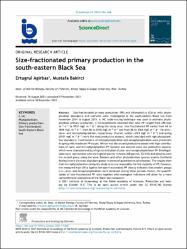| dc.contributor.author | Ağırbaş, Ertuğrul | |
| dc.contributor.author | Bakırcı, Mustafa | |
| dc.date.accessioned | 2022-10-31T05:53:40Z | |
| dc.date.available | 2022-10-31T05:53:40Z | |
| dc.date.issued | 2022 | en_US |
| dc.identifier.citation | Ağırbaş, E. & Bakırcı, M. (2022). Size-fractionated primary production in the south-eastern Black Sea. Oceanologia, 64(2), 244-266. https://doi.org/10.1016/j.oceano.2021.11.002 | en_US |
| dc.identifier.issn | 0078-3234 | |
| dc.identifier.issn | 2300-7370 | |
| dc.identifier.uri | https://doi.org/10.1016/j.oceano.2021.11.002 | |
| dc.identifier.uri | https://hdl.handle.net/11436/6846 | |
| dc.description.abstract | Size-fractionated primary production (PP) and chlorophyll-a (Chl-a) with phytoplankton abundance and nutrients were investigated in the south-eastern Black Sea from November 2014 to August 2015. A 14C radio-tracing technique was used to estimate phytoplankton primary production. C-14 experiments revealed that total PP ranged from 295 mgC m(-2) d(-1) to 5931 mgC m(-2) d(-1) along the study area. Size-fractionated PP varied from 84 to 1848 mgC m(-2) d(-1), from 96 to 3156 mgC m-2 d-1 and from 56 to 3363 mgC m(-2) d(-1) for pico-, nano- and microphytoplankton, respectively. Overall, winter (4163 mgC m(-2) d(-1)) and spring (5931 mgC m(-2) d(-1)) were the most productive seasons, which coincided with high phytoplankton abundance. Contributions of microphytoplankton and nanophytoplankton were prominent in spring with maximum PP values. Winter was the second productive season with high contributions of nano- and microphytoplankton PR. Summer and autumn were less productive seasons, which were characterised by a high contribution of pico- and nanophytoplankton PR. Dinoflagellates were represented with the highest species richness (68 species, 53.54%) and diatoms were the second group along the area. Diatoms and other phytoplankton species (mainly Emiliania huxleyi) were the most abundant groups in terms of quantitative contribution. The results show that microphytoplankton along the study area are responsible for the majority of PR. However, the measured high Chl-a against low size-fractionated PP clearly indicates that smaller groups (i.e., pico- and nanophytoplankton) were dominant during these periods. Hence, the quantification of size-fractionated PP rates together with ecological indicators will allow for a more comprehensive assessment of the Black Sea ecosystem. (C) 2021 Institute of Oceanology of the Polish Academy of Sciences. Production and hosting by Elsevier B.V. | en_US |
| dc.language.iso | eng | en_US |
| dc.publisher | Elsevier | en_US |
| dc.rights | info:eu-repo/semantics/openAccess | en_US |
| dc.subject | C-14 | en_US |
| dc.subject | Phytoplankton | en_US |
| dc.subject | Primary production | en_US |
| dc.subject | Size-fractionated | en_US |
| dc.subject | South-Eastern Black Sea | en_US |
| dc.title | Size-fractionated primary production in the south-eastern Black Sea | en_US |
| dc.type | article | en_US |
| dc.contributor.department | RTEÜ, Su Ürünleri Fakültesi, Su Ürünleri Temel Bilimler Bölümü | en_US |
| dc.contributor.institutionauthor | Ağırbaş, Ertuğrul | |
| dc.contributor.institutionauthor | Bakırcı, Mustafa | |
| dc.identifier.doi | 10.1016/j.oceano.2021.11.002 | en_US |
| dc.identifier.volume | 64 | en_US |
| dc.identifier.issue | 2 | en_US |
| dc.identifier.startpage | 244 | en_US |
| dc.identifier.endpage | 266 | en_US |
| dc.relation.journal | Oceanologia | en_US |
| dc.relation.tubitak | 113Y189 | |
| dc.relation.publicationcategory | Makale - Uluslararası Hakemli Dergi - İdari Personel ve Öğrenci | en_US |


















